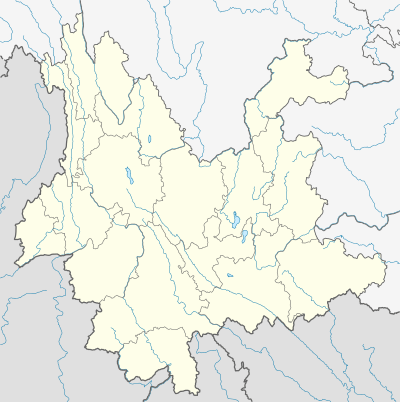Mojiang Hani Autonomous County
Mojiang Hani Autonomous County (simplified Chinese: 墨江哈尼族自治县; traditional Chinese: 墨江哈尼族自治縣; pinyin: Mòjiāng Hānízú Zìzhìxiàn) is an autonomous county under the jurisdiction of Pu'er City, in the south of Yunnan Province, China.
Mojiang County 墨江县 | |
|---|---|
Autonomous county | |
| 墨江哈尼族自治县 Mojiang Hani Autonomous County | |
.png) Location of Mojiang County (pink) and Pu'er City (yellow) within Yunnan | |
 Mojiang Location of the seat in Yunnan | |
| Coordinates: 23°25′55″N 101°41′31″E | |
| Country | People's Republic of China |
| Province | Yunnan |
| Prefecture-level city | Pu'er |
| GB/T 2260 CODE | 530822 |
| Area | |
| • Total | 5,312 km2 (2,051 sq mi) |
| Population | |
| • Total | 350,991 |
| • Density | 66/km2 (170/sq mi) |
| Time zone | UTC+8 (China Standard Time) |
| Postal code | 654800 |
| Area code(s) | 0879 |
| Website | www |
| 1Yunnan Statistics Bureau 2Puer Gov. 3Yunnan Portal | |
Demographics
There was a total of 210,628 ethnic Hani in Mojiang County as of 2006. Hani subgroups in Mojiang County include the following, with 2006 population estimates (Jiang, et al. 2009:3) and language classifications (Mojiang County Ethnic Gazetteer 2007:22).[1]
The Budu and Bukong are also found in Mojiang County.[2]
- Budu 布都 (17,498 people)
- Bukong 布孔 (14,106 people), including in Niangpuzhai 娘浦寨,[3] Mengli Village 勐里村, Longba Township 龙坝乡
According to the Mojiang County Almanac (2002:640), ethnic Bulang, who numbered 2,968 individuals as of 1993, are found in the townships of Jingxing 景星, Xinwu 新抚, and Tongguan 通关. The Bulang of Mojiang County speak Va, an Angkuic language.
In Mojiang County, ethnic Yao are found in Yaojia 瑶家[4] and Guangshan 光山[5] of Manxing Village 曼兴村, Wenwu Township 文武乡.[6]
Transport
Climate
| Climate data for Mojiang (1981−2010) | |||||||||||||
|---|---|---|---|---|---|---|---|---|---|---|---|---|---|
| Month | Jan | Feb | Mar | Apr | May | Jun | Jul | Aug | Sep | Oct | Nov | Dec | Year |
| Record high °C (°F) | 27.2 (81.0) |
29.4 (84.9) |
31.3 (88.3) |
33.4 (92.1) |
34.4 (93.9) |
32.1 (89.8) |
32.5 (90.5) |
32.7 (90.9) |
31.7 (89.1) |
30.2 (86.4) |
27.4 (81.3) |
25.6 (78.1) |
34.4 (93.9) |
| Average high °C (°F) | 20.3 (68.5) |
22.6 (72.7) |
25.5 (77.9) |
27.6 (81.7) |
27.8 (82.0) |
27.6 (81.7) |
27.1 (80.8) |
27.5 (81.5) |
26.6 (79.9) |
24.6 (76.3) |
21.8 (71.2) |
19.4 (66.9) |
24.9 (76.8) |
| Daily mean °C (°F) | 12.5 (54.5) |
14.3 (57.7) |
17.4 (63.3) |
20.0 (68.0) |
21.7 (71.1) |
22.7 (72.9) |
22.4 (72.3) |
22.2 (72.0) |
21.1 (70.0) |
19.1 (66.4) |
15.4 (59.7) |
12.4 (54.3) |
18.4 (65.2) |
| Average low °C (°F) | 7.0 (44.6) |
7.9 (46.2) |
10.7 (51.3) |
13.7 (56.7) |
16.9 (62.4) |
19.5 (67.1) |
19.6 (67.3) |
19.2 (66.6) |
18.0 (64.4) |
15.9 (60.6) |
11.5 (52.7) |
7.9 (46.2) |
14.0 (57.2) |
| Record low °C (°F) | −0.4 (31.3) |
1.9 (35.4) |
−0.1 (31.8) |
7.1 (44.8) |
10.1 (50.2) |
12.2 (54.0) |
15.8 (60.4) |
14.1 (57.4) |
9.7 (49.5) |
7.3 (45.1) |
2.5 (36.5) |
−2.5 (27.5) |
−2.5 (27.5) |
| Average precipitation mm (inches) | 16.6 (0.65) |
26.2 (1.03) |
27.8 (1.09) |
66.6 (2.62) |
134.5 (5.30) |
185.6 (7.31) |
272.3 (10.72) |
227.7 (8.96) |
155.1 (6.11) |
105.1 (4.14) |
67.2 (2.65) |
21.2 (0.83) |
1,305.9 (51.41) |
| Average relative humidity (%) | 76 | 69 | 63 | 66 | 75 | 81 | 84 | 84 | 83 | 83 | 82 | 80 | 77 |
| Source: China Meteorological Data Service Center | |||||||||||||
References
- 墨江哈尼族自治县民族宗教事务局编 (2007). 墨江哈尼族自治县民族志(1950-2005). Mojiang, China: 墨江哈尼族自治县民族宗教事务局.
- 《中国少数民族社会历史调查资料丛刊》修订编辑委员会. 2009. 哈尼族社会历史调查, p.94, 99. Beijing: Minzu Chubanshe.
- 墨江哈尼族自治县龙坝乡勐里村娘埔自然村 (in Chinese)
- 墨江哈尼族自治县文武乡曼兴村瑶家 (in Chinese)
- 墨江哈尼族自治县文武乡曼兴村光山 (in Chinese)
- 墨江瑶族社会调查 (in Chinese)
Notes
- Jiang Ying [蒋颖], Cui Xia [崔霞], Qiao Xiang [乔翔]. 2009. A study of Ximoluo [西摩洛语研究]. Beijing: Ethnic Publishing House [民族出版社].
- Yang Hong [杨洪], Zhang Hong [张红]. 2010. Demographics and current situations of Hani subgroups in Mojiang County [墨江哈尼族自治县哈尼支系与人口现状调查研究]. Journal of Honghe University [红河学院学报]. Vol. 8, No. 3. Jun. 2010. DOI:10.13963/j.cnki.hhuxb.2010.03.028